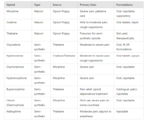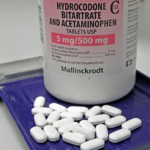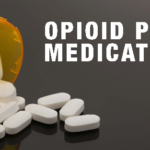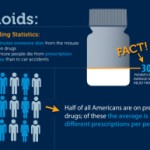The U.S. government does not track death rates for every drug. However, the National Center for Health Statistics (NCHS) at the Centers for Disease Control and Prevention collects information on deaths involving many of the more commonly used drugs available through 2019 at a searchable database, called CDC Wonder. The NCHS also has 12 month-ending provisional data available by state and drug category. See Provisional Drug Overdose Death Counts.
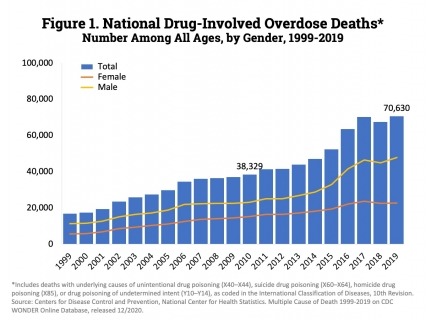
Figure 1. National Drug-Involved Overdose Deaths—Number Among All Ages, by Gender, 1999-2019. More than 70,000 Americans died from drug-involved overdose in 2019, including illicit drugs and prescription opioids. The figure above is a bar and line graph showing the total number of U.S. drug overdose deaths involving any illicit or prescription opioid drug from 1999 to 2019. The bars are overlaid by lines showing the number of deaths by gender from 1999 to 2018 (Source: CDC WONDER).
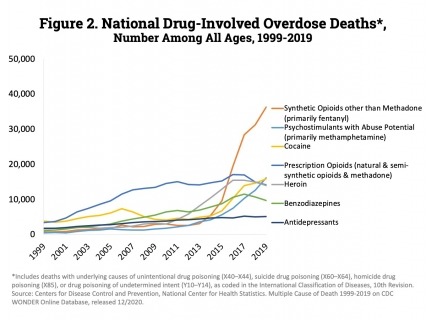
Figure 2. National Drug-Involved Overdose Deaths by Specific Category—Number Among All Ages, 1999-2019. Overall, drug overdose deaths rose from 2018 to 2019 with 70,630 drug overdose deaths reported in 2019. Deaths involving other synthetic opioids other than methadone (primarily fentanyl) continued to rise with more than 36,359 overdose deaths reported in 2019. Those involving psychostimulants with abuse potential (primarily methamphetamine) also continued to increase(Source: CDC WONDER).
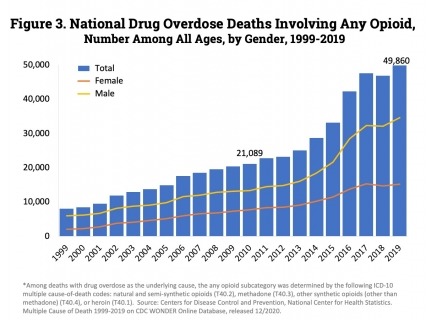
Figure 3. National Overdose Deaths Involving Any Opioid—Number Among All Ages, by Gender, 1999-2019. The figure above is a bar and line graph showing the total number of U.S. overdose deaths involving any opioid from 1999 to 2019. Any opioid includes prescription opioids (natural and semi-synthetic opioids and methadone), heroin and synthetic opioids other than methadone (primarily fentanyl). Opioid-involved overdose deaths rose from 21,088 in 2010 to 47,600 in 2017 and remained steady in 2018 with 46,802 deaths. This was followed by a significant increase in 2019 to 49,860 overdose deaths. The bars are overlaid by lines showing the number of deaths by gender from 1999 to 2019 (Source: CDC WONDER).
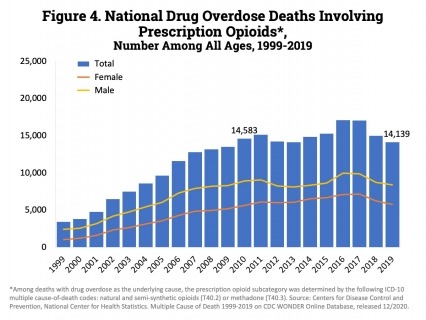
Figure 4. National Overdose Deaths Involving Prescription Opioids—Number Among All Ages, 1999-2019. The figure above is a bar and line graph showing the total number of U.S. overdose deaths involving prescriptions opioids (including natural and semi-synthetic opioids and methadone) from 1999 to 2019. Drug overdose deaths involving prescription opioids rose from 3,442 in 1999 to 17,029 in 2017. From 2017 to 2019, however, the number of deaths dropped to 14,139. The bars are overlaid by lines showing the number of deaths by gender from 1999 to 2019 (Source: CDC WONDER).
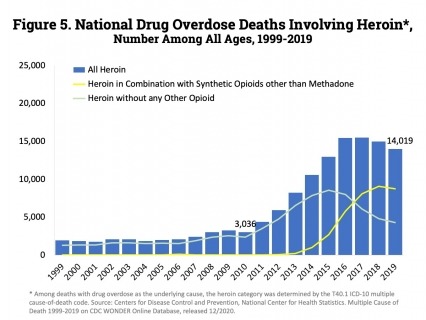
Figure 5. National Overdose Deaths Involving Heroin, by Other Opioid Involvement, Number Among All Ages, 1999-2019. The figure above is a bar and line graph showing the total number of U.S. overdose deaths involving heroin from 1999 to 2019. Drug overdose deaths involving heroin rose from 1,960 in 1999 to 15,469 in 2016. Since 2016, the number of deaths has trended down with 14,019 deaths reported in 2019. The bars are overlaid by lines showing the number of deaths involving heroin in combination with synthetic opioids other than methadone (primarily fentanyl) or without any other opioid from 1999 to 2019 (Source: CDC WONDER).
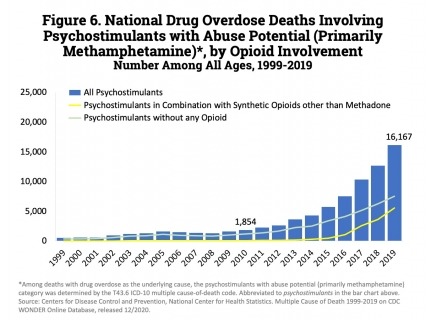
Figure 6. National Overdose Deaths Involving Psychostimulants With Abuse Potential (Including Methamphetamine), by Opioid Involvement, Number Among All Ages, 1999-2019. The figure above is a bar and line graph showing the total number of U.S. overdose deaths involving psychostimulants with abuse potential from 1999 to 2019. Drug overdose deaths rose from 547 in 1999 to 16,167 in 2019. The bars are overlaid by lines showing the number of deaths involving psychostimulants in combination with synthetic opioids other than methadone (primarily fentanyl) or without any opioid. The number of deaths involving psychostimulants has increased steadily since 2014 regardless of opioid involvement (Source: CDC WONDER).
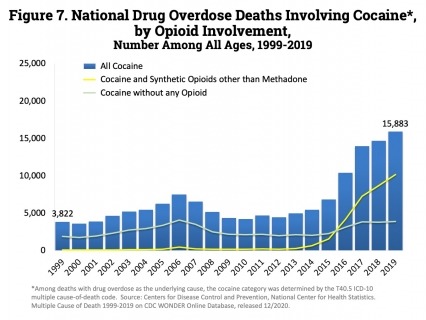
Figure 7. National Drug Overdose Deaths Involving Cocaine, by Opioid Involvement, Number Among All Ages, 1999-2019. The figure above is a bar and line graph showing the total number of U.S. overdose deaths involving cocaine from 1999 to 2019. Drug overdose deaths involving cocaine rose from 3,822 in 1999 to 15,883 in 2019. The bars are overlaid by lines showing the number of deaths involving cocaine in combination with synthetic opioids other than methadone (primarily fentanyl) or without any opioid. The number of deaths in combination with synthetic opioids other than methadone has been increasing steadily since 2014 and is the main driver of cocaine-involved overdose deaths (Source: CDC WONDER).
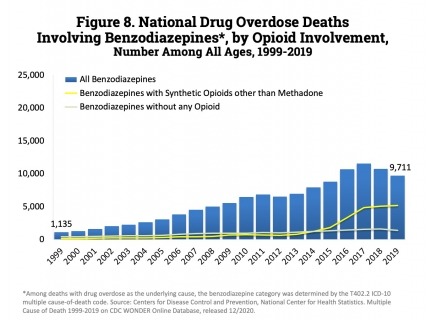
Figure 8. National Drug Overdose Deaths Involving Benzodiazepines, by Opioid Involvement, Number Among All Ages, 1999-2019. The figure above is a bar and line graph showing the total number of U.S. overdose deaths involving benzodiazepines from 1999 to 2019. Drug overdose deaths involving benzodiazepines rose from 1,135 in 1999 to 11,537 in 2017. Between 2017 and 2019, deaths declined to 9,711. The bars are overlaid by lines showing the number of deaths involving benzodiazepines in combination with synthetic opioids other than methadone (primarily fentanyl) or without any opioid (Source: CDC WONDER).
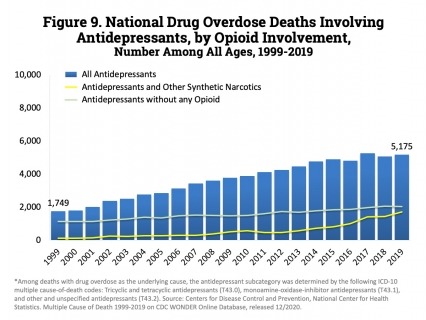
Figure 9. National Drug Overdose Deaths Involving Antidepressants, by Opioid Involvement–Number Among All Ages, 1999-2019. The figure above is a bar and line graph showing the total number of U.S. overdose deaths involving antidepressants from 1999 to 2019. Drug overdose deaths involving antidepressants has risen steadily from 1,749 in 1999 to 5,269 in 2017. Since then, deaths have remained steady with 5,175 in 2019. The bars are overlaid by lines showing the number of deaths involving antidepressants in combination with synthetic opioids other than methadone (primarily fentanyl) or without any opioid involvement (Source: CDC WONDER).
Description of Figures
- The figures above are bar charts showing the number of U.S. overdose deaths involving select prescription and illicit drugs from 1999 through 2019. The bars are overlaid by lines representing gender or concurrent opioid involvement. There were 70,630 drug-involved overdose deaths reported in the U.S. in 2019 (Figure 1); 68% of cases occurred among males (yellow line). Other synthetic opioids (primarily fentanyl) were the main driver of drug overdose deaths with a nearly 14-fold increase from 2012 to 2019 (Figure 2).
- Drug overdose deaths involving any opioid―prescription opioids (including natural and semi-synthetic opioids and methadone), other synthetic opioids (primarily fentanyl), and heroin―rose through 2017 with 47,600 deaths. In 2018, deaths remained steady followed by an increase in 2019 to 49,860 fatalities. Nearly 70% of deaths occurred among males (Figure 3). From 2018 to 2019, the number of deaths involving prescription opioids declined to 14,139 (Figure 4).
- Overdose deaths involving heroin decreased from 14,996 deaths in 2018 to 14,019 in 2019 (Figure 5).
- Since 2012, the number of deaths involving psychostimulants (primarily methamphetamine, Figure 6) have risen significantly each year, with 16,167 deaths in 2019. Cocaine too, has increased steadily since 2014 with 15,883 deaths reported in 2019 (Figure 7).
- The final two charts show the number of overdose deaths involving benzodiazepines (Figure 8) or antidepressants (Figure 9). Benzodiazepines were involved in 9,711 deaths in 2019—a steady decline from the 11,537 deaths in 2017. Deaths involving antidepressants have remained steady since 2014, with 5,175 fatalities reported in 2019. Deaths involving benzodiazepines or antidepressants are mainly driven by those also involving opioids.
